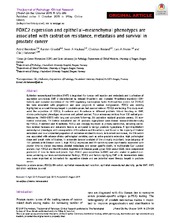FOXC2 expression and epithelial–mesenchymal phenotypes are associated with castration resistance, metastasis and survival in prostate cancer
Børretzen, Astrid; Gravdal, Karsten; Haukaas, Svein Andreas; Beisland, Christian; Akslen, Lars A.; Halvorsen, Ole Johan
Peer reviewed, Journal article
Published version

View/
Date
2019Metadata
Show full item recordCollections
Original version
https://doi.org/10.1002/cjp2.142Abstract
Epithelial–mesenchymal transition (EMT) is important for tumour cell invasion and metastasis and is a feature of aggressive carcinomas. EMT is characterised by reduced E‐cadherin and increased N‐cadherin expression (EN‐switch), and increased expression of the EMT‐regulating transcription factor Forkhead box protein C2 (FOXC2) has been associated with progression and poor prognosis in various malignancies. FOXC2 was recently highlighted as a novel therapy target in prostate cancer, but survival data on FOXC2 are lacking. This study evaluates the expression of FOXC2, E‐cadherin and N‐cadherin in different prostatic tissues focusing on EMT, clinico‐pathological phenotype, recurrence and patient survival. Tissue microarray sections from 338 radical prostatectomies (1986–2007) with long and complete follow‐up, 33 castration resistant prostate cancers, 33 non‐skeletal metastases, 13 skeletal metastases and 41 prostatic hyperplasias were stained immunohistochemically for FOXC2, E‐cadherin and N‐cadherin. FOXC2 was strongly expressed in primary carcinomas, including castration resistant tumours and metastatic lesions as compared to benign prostatic hyperplasia. A hybrid epithelial–mesenchymal phenotype, with co‐expression of E‐cadherin and N‐cadherin, was found in the majority of skeletal metastases and in a substantial proportion of castration resistant tumours. In localised carcinomas, the EN‐switch was associated with adverse clinico‐pathological variables, such as extra‐prostatic extension, high pathological stage and lymph node infiltration. In univariate survival analyses of the clinically important, large subgroup of 199 patients with Gleason score 7, high FOXC2 expression and EN‐switching were significantly associated with shorter time to clinical recurrence, skeletal metastases and cancer specific death. In multivariate Cox' survival analysis, high FOXC2 and the EN‐switch, together with Gleason grade group (GG3 versus GG2), were independent predictors of time to these end‐points. High FOXC2 gene expression (mRNA) was also related to patient outcome, validating our immunohistochemical findings. FOXC2 and factors signifying EMT or its intermediate states may prove important as biomarkers for aggressive disease and are potential novel therapy targets in prostate cancer.
